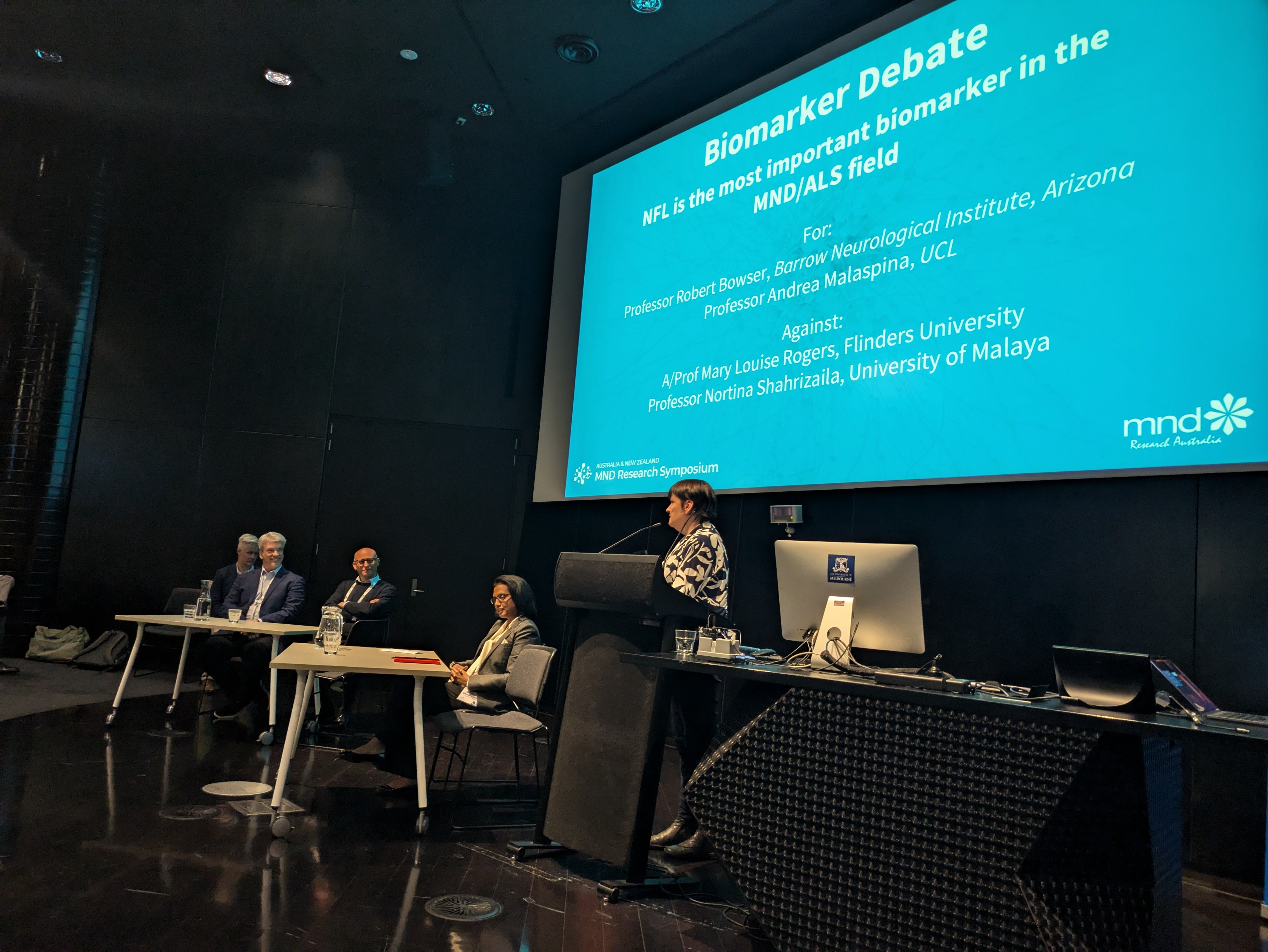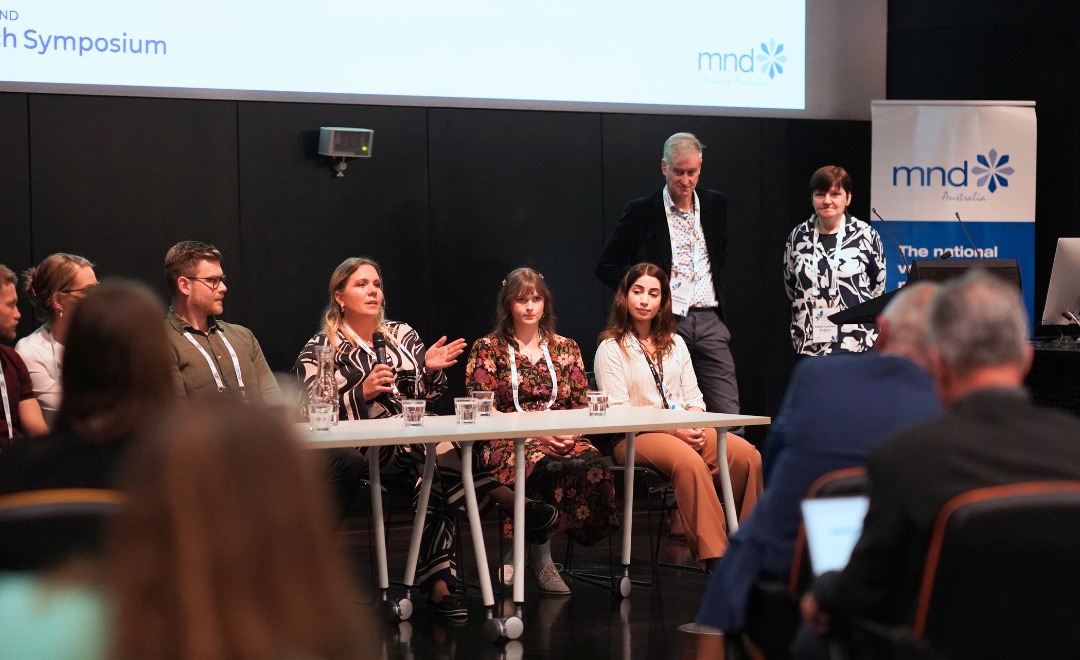MND Australia hosted the third Australian and New Zealand MND Research Symposium in Melbourne on the 27th and 28th of August 2024.
With a record number of over 300 registrants, including many with lived experience of motor neurone disease, the event was our most successful yet. With over 100 abstracts submitted, the Symposium featured a wealth of cutting-edge Australian MND research. A number of international world-class researchers also presented prior to participating in the FightMND Global Roundtable, which was held directly after the Symposium.
The Symposium kicked off with Professor Ammar Al-Chalabi from King’s College London UK, with a wide-ranging overview of “What causes MND?” His presentation covered genetic contributions and how they interact with other factors such as the environment.
Australian and New Zealand researchers talked about their advances in understanding “Biomarkers & Disease Stratification” and “Genetics, Genomics & Cellular Biology”. The possibility of studying changes in the tongue muscles to predict disease progression was one of the very novel topics. The session on genetics highlighted differences in the New Zealand population and what other health conditions might precede MND.
Establishing reliable biomarkers for MND would be a game changer, both in terms of research and diagnosis. We were fortunate to have four of the world’s premier experts in MND/ALS, namely Professor Robert Bowser (Barrow Neurological Institute, Arizona), Professor Andrea Malaspina (UCL), Associate Professor Mary Louise Rogers (Flinders University), and Professor Nortina Shahrizaila (University of Malaya) debate the topic. “Is NFL (neurofilament light chain) the most important biomarker in the MND/ALS field?” After a lively session, the consensus was: it is the best we currently have, but we need more options.
Biomarkers were a hot topic again on day two. Dr Lucie Bruijn, Senior Director of Translational Medicine at Novartis in the UK, opened the day’s proceedings by giving overview on “Development of Novel Therapies for ALS – A focus on biomarker development”. Dr Bruijn spoke about the challenge of finding treatments for ALS/MND. “It’s extremely variable,” she said, “Every person living with the disease can tell a different story”. Her presentation further highlighted the need for understanding of what the current biomarkers can tell us, and what we might see in the future.
Associate Professor Shyuan Ngo from University of Queensland, Australia, summarised the pros and cons of animal and human cell models and how they should be best utilised, in her presentation, “The translational challenge: do preclinical models meet our needs?” Other day two talks included “Novel Targets & Drug Development” and “Neuroinflammation”, which presented a number of different new approaches and candidates for treatment development. Several talks focussed on different approaches to better understand the MND process and attempts to identify the disease-associated changes at the molecular and cellular level.
In the afternoon, the focus shifted to consumer-facing research. Phil Camden, who is living with MND, opened the session with an insightful lived experience perspective on the disease. Professor Kevin Talbot from the University of Oxford then gave a high-level overview of the progress in “Targeting genes in the therapy of MND”. With Biogen’s drug Tofersen showing great effectiveness for treating patients carrying the SOD1 gene mutation, genetic therapies are proving that if we know what causes the disease then we can treat it effectively.
 Image credit: Florey Institute
Image credit: Florey Institute
Maintaining the focus on care delivery, Mr Iskhandar Razak from ABC News moderated a lively panel discussion on New Standards in Clinical Trials and Care featuring CEO of MND Victoria Kate Johnson, and Australian and international clinicians including Dr Natalie Gauld who is living with MND and the Research Advisor and Best Practice Advocate with MND New Zealand. The debate kicked off with the tough and as yet unanswerable question: when will see a cure for MND? It then evolved into a broader discussion of how we can best use the resources we have at our disposal now, and opportunities that may present themselves in the near future.
Dr Anne Hogden introduced the final speaker, Janet Hough, saying, “To my mind, this is the most important session of the last few days”. Janet Hough, who lives with MND, outlined how MND researchers are partnering with people with lived experience of MND through the MND Research Collective, through a series of case studies. Janet opened by saying she represented the 2,500 people living with MND, and the poignant reminder that every day in Australia, two people are diagnosed with MND, and two people die.
Speaking of the people living with MND, Janet said, “I journey with them as they face the challenges of MND as it progresses and their life gets more challenging and more difficult.” Janet also acknowledged Jenne, “a dynamic woman who herself has MND,” who initiated the group, but whose condition prevented her from presenting. “I am really honoured to be presenting what was her vision”.
State of Play |Insights from the 2024 Australia and New Zealand MND Research Symposium
Watch a selection of Symposium highlights on the MND Australia youtube page
By Dr Gethin Thomas, Executive Director of Research, and Melissa Fagan, Information Resource Manager
This symposium would not have possible without the generous support of our sponsors.
